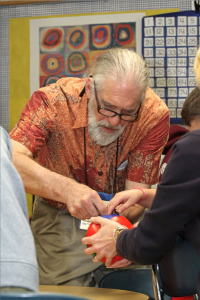The Multi-Week, Multi-School Math Residency for General and/or Special Education
Available as a Math Residency or Workshop and/or Consulting by Tom Schersten
Crunching the Math Common Core:
Visual Modeling and Problem-Solving
 A Math Residency provides training for teachers during school hours, starting with a demonstration teaching of topics chosen by the teachers. Participants see firsthand the classroom management of manipulative materials, as well as concrete activities that promote understanding and success in math. Model teaching is augmented by staff development and a Family Math Night. All lessons include handouts to facilitate implementation.
A Math Residency provides training for teachers during school hours, starting with a demonstration teaching of topics chosen by the teachers. Participants see firsthand the classroom management of manipulative materials, as well as concrete activities that promote understanding and success in math. Model teaching is augmented by staff development and a Family Math Night. All lessons include handouts to facilitate implementation.
The residency program is an intensive training for instructors of mathematics (kindergarten through geometry and algebra; general and special education) in problem solving and manipulative approaches to teaching the Common Core State Standards. Teachers observe lessons by the mathematician demonstrating a progression of activities from the introduction of a concrete material, through a series of interactions to develop skills, and finally to the transition to the abstract representation of the math concepts requested by the participants.
Tom provides the Common Core State Standards study guides for each grade level, as well as vertical articulations across grade levels of selected domains, such as Operations and Algebraic Thinking. Demonstration lessons are chosen to address particular Common Core State Standards and include teacher packets that explain the lessons and provide reproducible game mats and score sheets. Further, teachers are invited to contact the mathematician anytime they have questions related to math and math instruction.
Each week consists of four or five days, each day concentrating on a specific grade cluster: K/1, 2/3, 4/5, 6/8, 9/10, for example. Up to two dozen teachers from different schools are freed up by substitutes to observe a morning lesson of two to three hours, to break for lunch, and to reconvene for an afternoon workshop to move the lesson further. The next day follows the same routine, but with students and teachers of another grade cluster. For a greater impact on the growth of teaching practices, this cycle can repeated during the school year.
Ideally, the same teachers participating in the first week will continue to participate in the subsequent weeks in order to achieve the best follow-through. Participants develop a broadened philosophy of teaching math in a variety of contexts and become teacher-trainers in their own schools, sharing their new expertise. This branching model can affect a very large number of teachers and students.
NOTE: The above multi-school model also works well in a single school.
Suggested Math Residency Topics
Possible lessons include but are not limited to the following:
K – 2
Counting and number sense (2 – 5 sessions)
Early spatial experiences (2 – 5 sessions)
K – 6
Attributes, sets and logic (3 – 5 sessions)
K – 10
Problem – solving (2 – 5 sessions)
Geometry and spatial sense (2 – 5 sessions)
Games and puzzles (1 – 5 sessions)
Measurement (2 – 5 sessions)
Calculators (2 – 5 sessions)
2 – 4
Place value and addition (4 – 5 sessions)
Subtraction (4 – 5 sessions) Prerequisite: place value and addition
Money (4 – 5 sessions)
Time (4 – 5 sessions)
2 – 10
Permutations, combinations (2 – 4 sessions)
Probability (2 – 5 sessions)
3-D constructions (2 – 5 sessions)
Non-decimal bases (4 – 5 sessions)
3 – 6
Multiplication (4 – 5 sessions)
Division (4 – 5 sessions)
3 – 10
Fractions (4 – 5 sessions)
Tessellations (3 – 5 sessions)
Perimeter, area, volume (2 – 5 sessions)
Statistics (2 – 5 sessions)
Decimals (4 – 5 sessions)
6 – 10
Percentage, ratio, proportion (4 – 5 sessions)
Integers (4 – 5 sessions)
Solving equations (4 – 5 sessions)
Polynomials and powers (2 – 3 sessions)
Algebraic products, factoring (4 – 5 sessions)
Finite differences (2 – 3 sessions)
Note: The number of sessions is based upon student lessons of suggested durations:
K, 45 to 60 minutes; 1st through 3rd, 60 to 90 minutes; 4th through 10th, 75 to 120 minutes. Durations reflect the age of the participants and depth of treatment.

